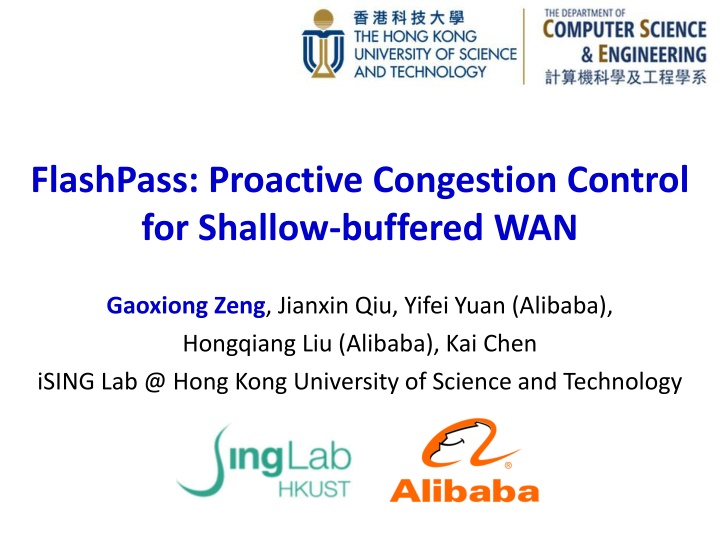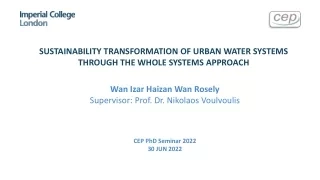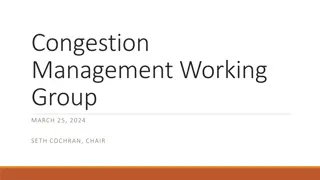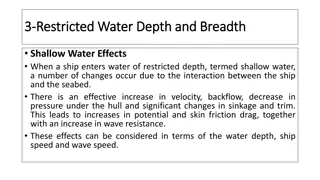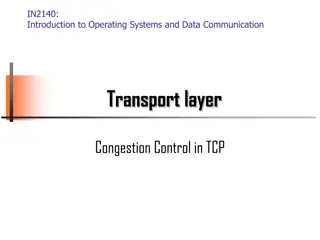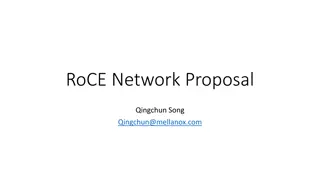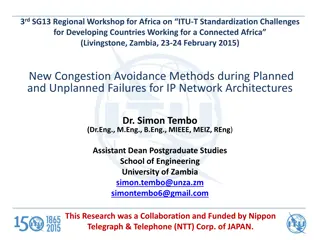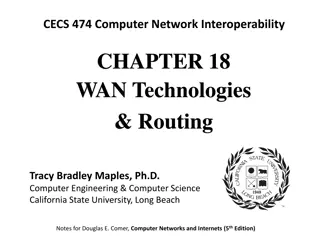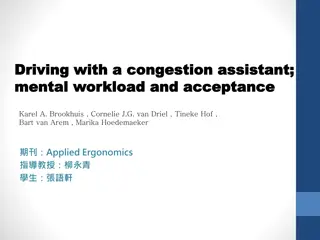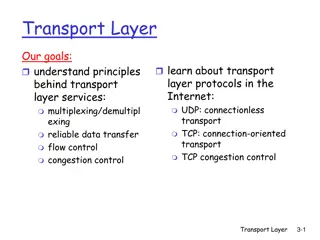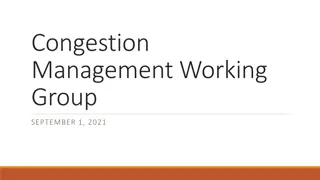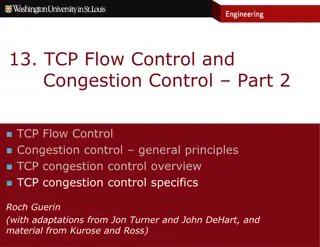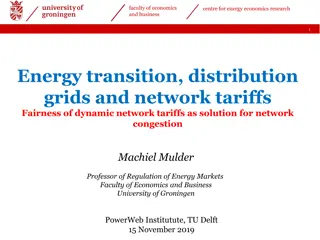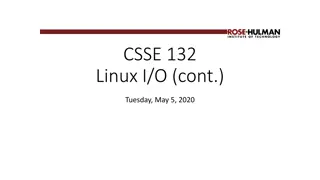FlashPass: Proactive Congestion Control for Shallow-buffered WAN
FlashPass presents a proactive congestion control solution for shallow-buffered WAN, aiming to enhance network performance and achieve zero queueing, particularly in Enterprise WAN environments. The paper discusses the challenges of shallow-buffered WAN, the shortcomings of reactive congestion control, and introduces proactive congestion control as a promising solution. It explores various congestion control algorithms and their impact on network throughput and loss. Experimental results show that with shallow buffers, network performance drops significantly, emphasizing the need for proactive congestion control to address these issues effectively.
Download Presentation

Please find below an Image/Link to download the presentation.
The content on the website is provided AS IS for your information and personal use only. It may not be sold, licensed, or shared on other websites without obtaining consent from the author.If you encounter any issues during the download, it is possible that the publisher has removed the file from their server.
You are allowed to download the files provided on this website for personal or commercial use, subject to the condition that they are used lawfully. All files are the property of their respective owners.
The content on the website is provided AS IS for your information and personal use only. It may not be sold, licensed, or shared on other websites without obtaining consent from the author.
E N D
Presentation Transcript
FlashPass: Proactive Congestion Control for Shallow-buffered WAN Gaoxiong Zeng, Jianxin Qiu, Yifei Yuan (Alibaba), Hongqiang Liu (Alibaba), Kai Chen iSING Lab @ Hong Kong University of Science and Technology
Inter-DC Wide-area Network Inter-DC WAN traffic (e.g., Google) is doubling every 9 months in the recent five years! Source: https://www.google.com/about/datacenters
Shallow-buffered WAN For flexible & cost-effective evolution, enterprises start to build their own customized WAN routers. They are often based on the shallow-buffered chips. ASIC BCM Trident+ BCM Trident2 BCM Trident3 BCM Trident4 Capacity (ports * BW) 48 * 10Gbps 32 * 40Gbps 32 * 100Gbps 32 * 400Gbps Total Buffer 9MB 12MB 32MB 132MB Buffer per port 192KB 384KB 1MB 4.125MB Buffer per port per Gbps 19.2KB 9.6KB 10.2KB 10.56KB High buffer pressure on WAN communication! 3
Reactive CC is Insufficient Buffer Requirement Analysis in Theory WAN BDP ~= 25MB >> 20KB (i.e., shallow buffer). Buffer requirement for high throughput & low loss Transport Signal Algorithm TCP Reno [1] Loss AIMD BDP*beta/(1-beta) = BDP (beta=0.5) TCP Cubic TCP Vegas Loss Delay & loss AIAD (MD on loss) 5*n pkts, n=flow# AIMD BDP*beta/(1-beta) = BDP/4 (beta=0.2) Copa Delay only AIAD 2.5*n/delta = 5*n pkts, n=flow# (delta=0.5) BBR No direct signal Not incremental (cwnd_gain-1)*BDP in Probe_BW phase (cwnd_gain = 2) [1] Guido Appenzeller, Isaac Keslassy, and Nick McKeown, "Sizing Router Buffers", in SIGCOMM 2004. 4
Reactive CC is Insufficient Experimental Results (10Gbps; RTT=40ms): With shallow buffer (~0.2MB in 10Gbps), network performance degrades significantly. Up to 40% reduction! 5
Proactive CC as a Solution Proactive congestion control (PCC) is promising to achieve zero queueing and high throughput. 1stRTT 2ndRTT credit data credit request credit 2ndrtt: 1strtt: Credit Credit Sender Receiver Sender Receiver Credit Request Data ExpressPass [sigcomm 17] (our baseline): credits emulate data sending in separate queue. NDP [sigcomm 17]: pure receiver scheduling + switch cutting payload. Homa [sigcomm 18]: pure receiver scheduling + switch multiple Q + overcommitment. issues to work practically on WAN! Existing PCCs are mostly designed for DCN, and have 7
Problem 1: Imperfect Scheduling Issue Data sending time has at least 1-way network delay after the credit sending. However, different flows have different delays/RTTs. Data Crash / Under-utilization 8
Problem 1: Imperfect Scheduling Issue Example (data crash): Start time Credit send Data Send Data arrive Flow 1 Flow 2 0ms 30ms 20-40ms 40-60ms Interleaved. 40-60ms 50-70ms ~60-80ms ~60-80ms Data crash! Different RTTs 9
Problem 2: Credit Termination Issue What to do after sending credits for the last data byte? 1.Aggressive credit generation: keep sending credits until receivers ack back. 2.Passive credit generation: not sending credits without further credit requests. Credit Wastage Long Tail Latency ExpressPass (Aggressive credit generation) 1Gbps, RTT=60ms 10
FlashPass Design Challenges: 1. Handle imperfect scheduling under diverse RTTs. 2. Handle credit termination issue in the last RTT. Design Choices: Sender-driven emulation mechanism (C1). Send time calibration with timestamp info. Over-provisioning with selective dropping (C2). 11
Sender-driven Emulation FlashPass is the first sender-driven PCC design. 12
Sender-driven Emulation Sender-driven emulation rehearses the future transmission with forward emulation packets (1). Same direction as the real data forwarding, unlike backward emulation (2) of receiver-driven solutions. 13
Sender-driven Emulation Send time calibration: Add timestamp on the emulation and credit packets. Data sending is scheduled to a fixed timeafter emulation. Example: Start time Credit send Data Send Data arrive Flow 1 0ms 20-40ms 40-60ms ~60-80ms Flow 2 30ms 40-60ms Interleaved. 70-90ms Fixed time delay ~80-100ms No crash! 14
Over-Provisioning with Selective Dropping Sending over-provisioned packets in the last RTT. Packet tagging at end-host Selective dropping in the network 2 2 Dropping Threshold 1 2 2 1 2 Emulation Queue 1 1 Network Fabric Ordinary emulation packets. Last RTT over-provisioned emulation packets. 15
Over-Provisioning with Selective Dropping Case-1: network is under-utilized. Dropping Threshold 2 2 2 2 Egress Queue Network Fabric Ordinary emulation packets. Spare bandwidth is utilized & no extra delay for credit generation. Last RTT over-provisioned emulation packets. 16
Over-Provisioning with Selective Dropping Case-2: network is fully-utilized. 1 1 Dropping Threshold 1 2 2 1 2 Egress Queue 2 2 Network Fabric Ordinary emulation packets. Credit wastage can be prevented & No link under-utilization. Last RTT over-provisioned emulation packets. 17
Evaluation Measurement on a regional WAN of Alibaba: We conduct evaluation with ns2 simulation. Protocols evaluated: TCP Cubic, ExpressPass & FlashPass. 18
Evaluation Can FlashPass achieve high throughput and low loss? Experiment setting: Static flows from N senders to the same receiver; All links have 10Gbps capacity; Metrics: throughput & loss rate. 19
Evaluation Can FlashPass achieve high throughput and low loss? In static traffic experiments, FlashPass consistently achieves high throughput with zero loss. 20
Evaluation How does FlashPass perform under realistic workload? Experiment setting: Dynamic flows are generated based on our measurement; All links have 10Gbps capacity; Metrics: flow completion time (FCT). 21
Evaluation How does FlashPass perform under realistic workload? Overall flow completion times: -32% (vs TCP Cubic) and -11.4% (vs ExpressPass) Figure 1: FCT results. Average load = 0.4. * indicates the Aeolus-enhanced version. 99-th tail small flow completion times: -49.5% (vs TCP Cubic) and -38% (vs ExpressPass) Figure 2: FCT results. Average load = 0.8. * indicates the Aeolus-enhanced version. 22
Evaluation Deep Dive How do parameters of FlashPass affect its network performance? - Figure A. How effective is the over-provisioning with selective dropping mechanism of FlashPass? - Figure B. Figure B Figure A 23
Summary of FlashPass Revealed the trend of using shallow-buffered switches on the inter-DC WAN. Demonstrated the insufficiencies of reactive congestion control for shallow-buffered WAN. Explored the proactive congestion control on WAN, and designed FlashPass that addresses several practical challenges. 24
Thanks! 25
